八年级英语第八单元第二话题C部分市级优质课
- 格式:ppt
- 大小:4.03 MB
- 文档页数:27

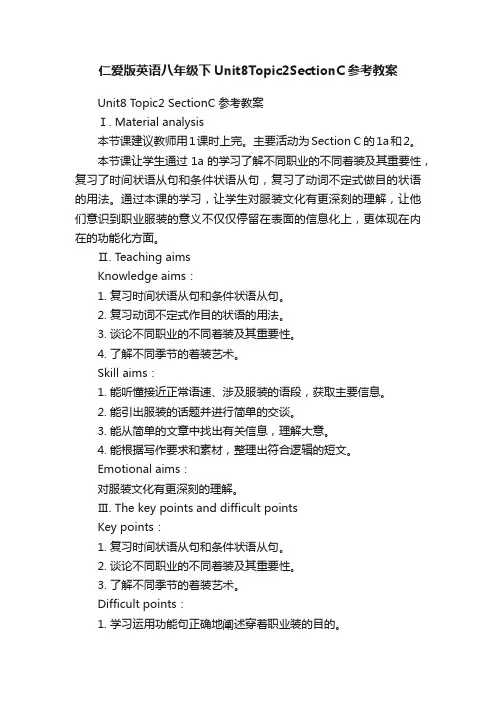
仁爱版英语八年级下Unit8Topic2SectionC参考教案Unit8 Topic2 SectionC 参考教案Ⅰ. Material analysis本节课建议教师用1课时上完。
主要活动为Section C 的1a和2。
本节课让学生通过1a的学习了解不同职业的不同着装及其重要性,复习了时间状语从句和条件状语从句,复习了动词不定式做目的状语的用法。
通过本课的学习,让学生对服装文化有更深刻的理解,让他们意识到职业服装的意义不仅仅停留在表面的信息化上,更体现在内在的功能化方面。
Ⅱ. Teaching aimsKnowledge aims:1. 复习时间状语从句和条件状语从句。
2. 复习动词不定式作目的状语的用法。
3. 谈论不同职业的不同着装及其重要性。
4. 了解不同季节的着装艺术。
Skill aims:1. 能听懂接近正常语速、涉及服装的语段,获取主要信息。
2. 能引出服装的话题并进行简单的交谈。
3. 能从简单的文章中找出有关信息,理解大意。
4. 能根据写作要求和素材,整理出符合逻辑的短文。
Emotional aims:对服装文化有更深刻的理解。
Ⅲ. The key points and difficult pointsKey points:1. 复习时间状语从句和条件状语从句。
2. 谈论不同职业的不同着装及其重要性。
3. 了解不同季节的着装艺术。
Difficult points:1. 学习运用功能句正确地阐述穿着职业装的目的。
2. 根据要求,运用本节知识重点整理出符合逻辑的短文。
Ⅳ. Learning strategies写作时要有鲜明的观点才能保证文章脉络的清晰。
Ⅴ. Teaching aidsComputer multimedia projector; the pictures of an official, boots, and the four seasons. Ⅵ. Teaching proceduresIntroduction(8 minutes)1. Greet students and make them ready for learning.2. The teacher shows the pictures of 2 in Section B. Let students make sentences with the structures It’s + adj. + (for sb. ) to do sth. and It’s + adj. + that …3. The teacher shows the pictures of 1a in Section B and the key words on the screen. Let students act out the four conversations with Could you tell me…? and You should/ have to…4. The teacher presents some sentences about dressing. Let students judge whether they are suitable or not. If not, let students correct them orally.For example:(1) When I am at home, I should wear a business suit.(2) If I go to a formal party, I should wear jeans.(3) When I am playing basketball, I should wear leather shoes.(4) When we have P.E. classes, we should wear sports shoes.5. The teacher summarizes and leads to 1a: It’s very important to wear suitable clothes on every occasion in our daily life, or in our everyday life. Some people have to wear their uniforms when they are at work. Let’s learn some of them.Presentation (10 minutes)1. The teacher lets students look at Picture 1 of 1a and addsa picture of officials. Let students discuss the jobs of the peoplein the pictures with their partner. Teach the words firefighter, heat and ceiling by introducing the firefighter in the picture. Teach the words soldier, official, officer and patients by showing their pictures. Teach the word airport by explaining that the pilot works in the airport. Teach the words reason and spread by showing their Chinese meanings.2. The teacher asks students to observe the pictures again and discuss what functions of their uniforms are.3. The teacher lets two or three students speak out their opinions.4. The teacher asks students to skim the passage and compare their opinions with the writer’s.5. The teacher asks students to read the passage again and answer the questions: How many kinds of uniforms are there in the text? What are they? Teach the new word text.6. The teacher lets two or three students tell their answers.Consolidation (10 minutes)1. The teacher plays the recording sentence by sentence.2. The teacher plays the recording without stopping.3. The teacher asks students to complete the table of 1b.4. The teacher asks two students to tell the answers. Remind them to pay attention to the usage of infinitives (to +v.).5. The teacher lets students find out the object clauses, adverbial clauses of time and condition as well as difficult points. Solve the difficult points together with the students.(1) Firefighters wear special coats and helmets to protect themselves from heat and falling ceilings.(2) When we see airline pilots wearing uniforms at the airport, we believe that they know how to fly the plane.(3) If we have a car accident on the street and we see a policeofficer in uniform, we know we can get help from him or her.6. The teacher lets students prepare to retell the passage with the help of 1b within their groups.Practice (10 minutes)1. The teacher lets students discuss with their group members whether students should wear uniforms at school. Allow them to have their own opinions. Teach the new word opinion and the phrase in one’s opinion.2. The teacher lets the representative of each group report their opinions.3. The teacher lets the students write a passage about the opinions of their own groups.4. The teacher evaluates their reports. And stress the advantage and importance ofdressing school uniforms.5. The teacher asks students to learn the new words in the brackets of 3a by themselves with the help of the similar words. Teach the new words boot and casual clothes by showing the pictures of them.(1) great →greatlybeautiful →beautifully(2) north +ern →northernsouth + ern →southerneast + ern →easternwest+ ern →western6. The teacher lets students skim the passage of 3a and know about the general ideas. Then let them choose the correct words to complete the passage.7. The teacher lets two students report their answers.Production (7 minutes)1. The teacher asks the students to read 3a again and fill in the table of 3b.2. The teacher lets two students tell the answers.3. T he teacher lets students work in pairs. Let them survey their partner’s favorite clothes in different seasons and complete the table.Season Clothesspringsummerfallwinter4. The teacher lets students report the result of the survey.5. The teacher guides students to write a passage according to their report.6. The teacher lets two students write down their passages on the blackboard. Then revise them together with the students.7. The teacher shows the summary of this section to the students.8. The teacher assigns homework:(1) Review the summary after class.(2) Write a passage about your family’s job and their uniforms.(3) Preview section D.Teaching ReflectionStudents learn a lot about the importance of uniforms. Many of them didn’t like wearing the school uniforms before, but now they know it’s necessary for them to wear the school uniforms. The teacher may design more sentences or draw some pictures about dressing suiting different jobs, seasons, occasions and so on, let students judge whether they are suitable or not.Ⅶ. Blackboard designUnit 8 Our ClothesTopic 2 We can design our own uniforms.Section C1. Firefighters wear special coats and helmets to protect themselves from heat and falling ceilings.2. When we see airline pilots wearing uniforms at the airport, we believe that they know how to fly the plane.3. If we have a car accident on the street and wesee a police officer in uniform, we know we canget help from him or her.1. great →greatlybeautiful →beautifully2. north +ern →northernsouth + ern →southerneast + ern →easternwest+ ern →western。
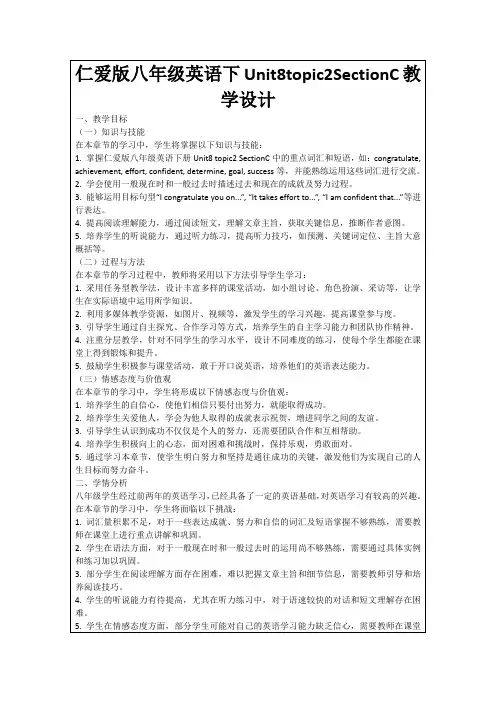
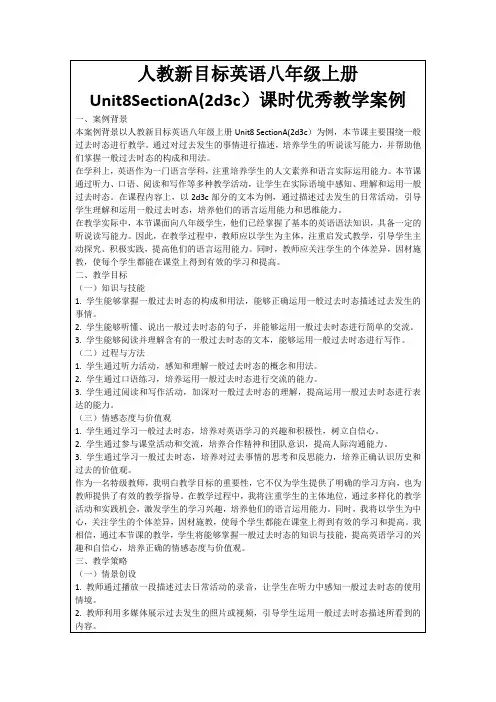
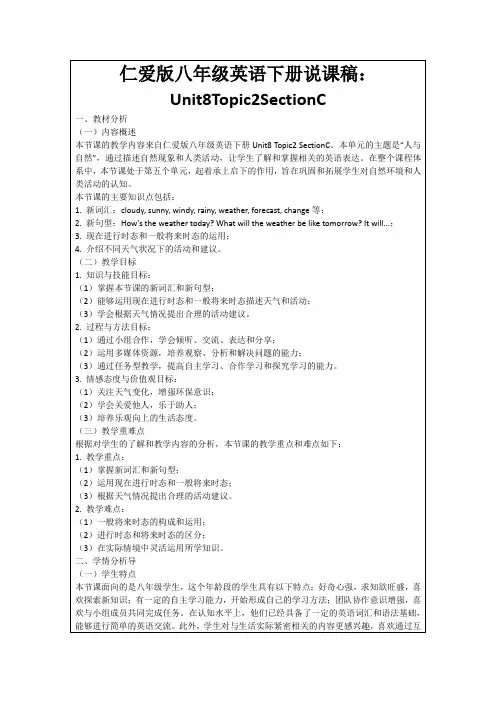
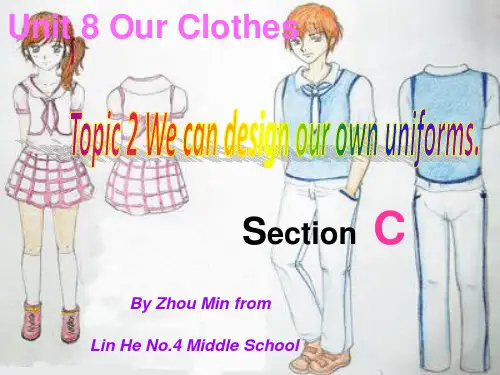


Section CSection C nee ds 1 period. Section C需用1课时。
The main activity is 1a. 本课重点活动是1a。
Ⅰ. Aims and demands目标要求1. Learn some new words:ceiling, soldier, hide, pilot, airport, police, officer, require2. Learn that different jobs require different uniforms.3. Learn the functions of different uniforms:Some uniforms show g ood discipline, some protect those who wear them, and others help us find the special people who wear them.4. Review adverbial clasuses of time and condition.Ⅱ. Teaching aids 教具人物图片/录音机/服装图片/小黑板/学生自备的家庭照Ⅲ. Five-finger Teaching Plan 五指教学方案Step 1 Review 第一步复习(时间: 5分钟)复习section B, 引入1a。
1. (师生对话,复习上节课所学内容。
)T: Good morning, boys and girls.Ss: Good morning, Miss … / Mr. …T: All of you look beautiful today!Ss: Thank you!T: W e all want to look nice. Girls want to look more attractive and boys want to look more handsome. But it is important for us to wear suitable clothes on every occasion.2. (学生分两组表演短剧。



Section CSection C nee ds 1 period. Section C需用1课时。
The main activity is 1a. 本课重点活动是1a。
Ⅰ. Aims and demands目标要求1. Learn some new words:ceiling, soldier, hide, pilot, airport, police, officer, require2. Learn that different jobs require different uniforms.3. Learn the functions of different uniforms:Some uniforms show g ood discipline, some protect those who wear them, and others help us find the special people who wear them.4. Review adverbial clasuses of time and condition.Ⅱ. Teaching aids 教具人物图片/录音机/服装图片/小黑板/学生自备的家庭照Ⅲ. Five-finger Teaching Plan 五指教学方案Step 1 Review 第一步复习(时间: 5分钟)复习section B, 引入1a。
1. (师生对话,复习上节课所学内容。
)T: Good morning, boys and girls.Ss: Good morning, Miss … / Mr. …T: All of you look beautiful today!Ss: Thank you!T: W e all want to look nice. Girls want to look more attractive and boys want to look more handsome. But it is important for us to wear suitable clothes on every occasion.2. (学生分两组表演短剧。
Unit8 Topic2 Section C 教案一、学习目标确定的依据:1、课程标准相关要求:《英语课程标准》(2011年版)要求学生能够会读会写知汉意的单词和短语1.单词:text reason firefighter heat ceiling soldier official airport officer patient spreaddaily2. 短语:in one ' s opinionC:语法:(1)学习引导词是特殊疑问词的宾语从句(2)It ' s+形容词+that+从句”句型2、教材分析:本课主要是通过了解制服的社会功能来继续学习宾语从句和it作形式主语<首先通过玩“看一看,说一说”游戏,复习以前学过的有关职业的名称,引出本课的部分单词。
本课有许多新词汇,但是基本上都可以利用上下文来猜测出意思。
教师要培养学生的猜测能力。
3、中招考点:~"引导词是特殊疑问词的宾语从句以及""It ' s+形容词+that+从旬”句型是学生必须掌握的知识要点,所以一定要让学生弄明白。
4学情分析:部分学生学习兴趣不是很足,引导词是特殊疑问词的宾语从句以及It ' s+形容词+that+从句”句型又十分重要,鉴于这一点,上课前应当充分备足课,知识点应让学生自己一点一点地归纳出来,努力提高学生的学习兴趣。
、学习目标1.学习并掌握P93-94的生词、短语及句型。
2.能够正确说出引导词是特殊疑问词的宾语从句和“It ' s+形容词+that+从句”句型。
二、评价任务1、针对目标1,通过学习P93-94的生词,能使学生在特定的语境中理解运用所学的生词。
2针对目标2,通过熟读1a,能够找出1a的知识点,牢记并能正确做出相关练习题。
八年级下册教案设计Unit 8 Our ClothesTopic 2 We can design our own uniforms.Section CⅠ. Material analysis本节课建议教师用1课时上完。
主要活动为Section C 的1a和2。
本节课让学生通过1a的学习了解不同职业的不同着装及其重要性,复习了时间状语从句和条件状语从句,复习了动词不定式做目的状语的用法。
通过本课的学习,让学生对服装文化有更深刻的理解,让他们意识到职业服装的意义不仅仅停留在表面的信息化上,更体现在内在的功能化方面。
Ⅱ. Teaching aimsKnowledge aims:1. 复习时间状语从句和条件状语从句。
2. 复习动词不定式作目的状语的用法。
3. 谈论不同职业的不同着装及其重要性。
4. 了解不同季节的着装艺术。
Skill aims:1. 能听懂接近正常语速、涉及服装的语段,获取主要信息。
2. 能引出服装的话题并进行简单的交谈。
3. 能从简单的文章中找出有关信息,理解大意。
4. 能根据写作要求和素材,整理出符合逻辑的短文。
Emotional aims:对服装文化有更深刻的理解。
Ⅲ. The key points and difficult pointsKey points:1. 复习时间状语从句和条件状语从句。
2. 谈论不同职业的不同着装及其重要性。
3. 了解不同季节的着装艺术。
Difficult points:1. 学习运用功能句正确地阐述穿着职业装的目的。
2. 根据要求,运用本节知识重点整理出符合逻辑的短文。
Ⅳ. Learning strategies写作时要有鲜明的观点才能保证文章脉络的清晰。
Ⅴ. Teaching aidsComputer multimedia projector; the pictures of an official, boots, and the four seasons.Ⅵ. Teaching proceduresStep InteractionpatternStudent activity Teacher activityntroduction (8 minutes)1. The wholeclass work.2. The wholeclass work.3. Pair work.4. The wholeclass work..5. The wholeclass work.1. Focus their attentionon the teacher.2. Students make sentenceswith the structures It’s+ adj. + (for sb. ) todo sth. and I t’s + adj. +that …3. Students act out thefour conversations withCould you tell me…?and You should/ haveto…4. Students judge whetherthese sentences aresuitable or not.5. Students should havethe right sense: we mustwear suitable clothes onevery occasion in ourdaily life. Learn the newword daily with thehelp of the teacher.1. Greet students and makethem ready for learning.2. The teacher shows the picturesof 2 in Section B. Letstudents make sentenceswith the structures It’s+adj. + (for sb. ) to do sth.and I t’s + adj. + that …3. The teacher shows the picturesof 1a in Section B and thekey words on the screen.Let students act out the fourconversations with Couldyou tell me…? and Youshould/ have to…4. The teacher presents somesentences about dressing.Let students judge whetherthey are suitable or not. If not,let students correct them orally.For example:(1) When I am at home, Ishould wear a businesssuit.(2) If I go to a formal party,I should wear jeans.(3) When I am playingbasketball, I shouldwear leather shoes.(4) When we have P.E.classes, we should wearsports shoes.5. The teacher summarizes andleads to 1a: It’s very importantto wear suitable clotheson every occasion in our dailylife, or in our everyday life.Some people have to weartheir uniforms when theyare at work. Let’s learnsome of them.Presentation (10 minutes) 1. Pair work.2. Group work.3. Two or threestudents’ work.4. Individualwork.5. The wholeclass work.6. The wholeclass work.1. Students discuss thejobs of the people inthe pictures with theirpartner. Learn and masterthe new words withthe help of the teacher.2. Students observe thepictures again and discusswhat functions of theiruniforms are.3. Students speak outtheir opinions.4. Students skim thepassage and comparetheir opinions with thewriter’s.5. Students read the passageagain and answer thequestions.6. Students check theanswers.1. The teacher lets studentslook at Picture 1 of 1aand adds a picture ofofficials. Let studentsdiscuss the jobs of thepeople in the pictures withtheir partner. T each the wordsfirefighter, heat and ceilingbyintroducing the firefighterin the picture. T each the wordssoldier, official, officerand patients by showingtheir pictures. Teach the wordairport by explaining thatthe pilot works in the airport.T each the words reason andspread by showing theirChinese meanings.2. The teacher asks studentsto observe the pictures againand discuss what functionsof their uniforms are.3. The teacher lets two orthree students speak outtheir opinions.4. The teacher asks studentsto skim the passage andcompare their opinions withthe writer’s.5. The teacher asks studentsto read the passage againand answer the questions:How many kinds of uniformsare there in the text?What are they? Teach thenew word text.6. The teacher lets two orthree students tell theiranswers.Consolidation (10 minutes) 1. The wholeclass work2. The wholeclass work3. Individualwork.4. The wholeclass work.5. Individualwork + thewhold classwork.6. Group work.1. Students read the passageafter the recordingsentence by sentence.2. Students try to followthe speed, paying attentionto the pronunciationand intonation.3. Students read 1a andcomplete the table of1b.4. Students check theanswers.5. Students read the passageand find out the mainpoints. Understand thepassage with the helpof the teacher.6. Students prepare to retellthe passage with the helpof 1b within their groups.1. The teacher plays the recordingsentence by sentence.2. The teacher plays therecording without stopping.3. The teacher asks students tocomplete the table of 1b.4. The teacher asks two studentsto tell the answers. Remindthem to pay attention tothe usage of infinitives (to+v.).5. The teacher lets students findout the object clauses,adverbial clauses of timeand condition as well asdifficult points. Solve thedifficult points togetherwith the students.(1) Firefighters wear specialcoats and helmets toprotect themselves fromheat and falling ceilings.(2) When we see airlinepilots wearing uniformsat the airport, we believethat they know how tofly the plane.(3) If we have a car accidenton the street and wesee a police officer inuniform, we know wecan get help from himor her.6. The teacher lets students prepareto retell the passage with thehelp of 1b within their groups.Practice (10 minutes) 1. Group work.2. The wholeclass work.3. Individualwork.4. The wholeclass work.5. The wholeclass work.6. Individualwork.7. The wholeclass work.1. Students discuss withtheir group memberswhether students shouldwear uniforms at school.2. Students report theiropinions.3. Students write a passageabout the opinions oftheir own groups.4. Students should knowmore about the advantageand importance ofdressing school uniforms.5. Students learn the newwords in the bracketsof 3a by themselveswith the help of thesimilar words.6. Students choose thecorrect words to completethe passage.7. Students check theanswers.1. The teacher lets studentsdiscuss with their groupmembers whether studentsshould wear uniforms atschool. Allow them tohave their own opinions. T eachthe new word opinion andthe phrase in one’s opinion.2. The teacher lets therepresentative of eachgroup report their opinions.3. The teacher lets the studentswrite a passage about theopinions of their own groups.4. The teacher evaluates theirreports. And stress theadvantage and importanceof dressing school uniforms.5. The teacher asks students tolearn the new words inthe brackets of 3a bythemselves with the helpof the similar words.Teach the new words bootand casual clothes byshowing the pictures of them.(1) great →greatlybeautiful →beautifully(2) north +ern →northernsouth + ern →southerneast + ern →easternwest+ ern →western6. The teacher lets students skimthe passage of 3a and knowabout the general ideas.Then let them choose thecorrect words to completethe passage.7. The teacher lets two studentsreport their answers.Production (7 minutes) 1. Individualwork.2. The wholeclass work.3. Pair work.4. The wholeclass work5. Individualwork.6. The wholeclass work.7. The wholeclass work.8. Individualwork1. Students read 3a againand fill in the table of3b.2. Students check theanswers.3. Students survey theirpartner’s favorite clothesin different seasons,and complete the table.4. Students report theresult of the survey.5. Students write a passageaccording to their report.6. Students revise thepassages written onthe blackboard.7. Students summarizeSection C with theteacher.8. Students finish afterclass.1. The teacher asks the studentsto read 3a again and fill inthe table of 3b.2. The teacher lets two studentstell the answers.3. The teacher lets students workin pairs. Let them surveytheir partner’s favoriteclothes in different seasonsand complete the table.Season Clothesspringsummerfallwinter4. The teacher lets students reportthe result of the survey.5. The teacher guides studentsto write a passage accordingto their report.6. The teacher lets two studentswrite down their passageson the blackboard. Thenrevise them together withthe students.7. The teacher shows thesummary of this sectionto the students.8. The teacher assigns homework:(1) Review the summaryafter class.(2) Write a passage aboutyour family’s job andtheir uniforms.(3) Preview section D.Teaching ReflectionStudents learn a lot about the importance of uniforms. Many of them didn’t like wearing the school uniforms before, but now they know it’s necessary for them to wear the school uniforms. The teacher may design more sentences or draw some pictures about dressing suiting different jobs, seasons, occasions and so on, let students judge whether they are suitable or not.Ⅶ. Blackboard designUnit 8 Our ClothesTopic 2 We can design our own uniforms.Section C1. Firefighters wear special coats and helmets to protectthemselves from heat and falling ceilings.2. When we see airline pilots wearing uniforms at the airport, we believe that they know how to fly the plane.3. If we have a car accident on the street and wesee a police officer in uniform, we know we canget help from him or her. 1. great →greatly beautiful →beautifully 2. north +ern →northern south + ern →southern east + ern →eastern west+ ern →western。
初二年级组英语教案课题八年级上册Unit8Topic2Different job require different uniforms .备课时间2013.6.26 使用时间2013.6主备人高志强使用人初二全体英语教师教学目标语言知识类别词汇语法功能与话题语言技能听 1. 说 1.读 1.写情感态度1.学习策略1.教学过程Section A 修改建议Language points1. allow vt.,意为“允许”。
allow sb. to do sth. 表示“允许某人做某事”。
e.g.My parents don’t allow me to watch TV too late.我父母不允许我看电视看得太晚。
allow后面可接v.-ing形式。
e.g.We don’t allow talking with each other in class. 我们不允许在课堂上互相交谈。
plain clothes 便服Soldiers wear plain clothes on leave, not uniform.士兵度假时穿便服,不穿制服。
interview v. 采访I’ll interview an office worker this afternoon.2. carry out 贯彻;执行;实现e.g.They didn’t carry out their plan.他们没有执行他们的计划。
She had finally carried out her promise to stop smoking. 她最终实现了戒烟的诺言。
The boss wanted his workers ____ the plan soon.A. carry outB. to carry outC. carried outD. carrying out3. depend on 依靠depend on +sb. / sth.Children depend on their parents for food and clothing.儿童的衣食靠父母。
人教版八年级上册第八单元Section B 2a-2c 教案Learning aims:* Key words and phrases:Thanksgiving;traditional;autumn;traveler;England;celebrate;mix;pepper;fill;oven;plate;cover;gravy;serve;temperature ;at this time;give thanks to sb for sth;cut...into;cover...with;fill...with;serve …to;celebrate…by…;mix together;Target language:It is always on the fourth Thursday in November.It is a time to give thanks for food in the autumn.Most Americans still celebrate this idea of giving thanks by having a big meal at home with their family.The main dish of this meal is almost always turkey;a large birdFill the turkey with this bread mix.Cover it with gravy.Cut the turkey into thin pieces.* Improve students’ integrating skills: reading skillsTeaching procedure:1. Warming up:Watch the video about the history of Thanksgiving in the United States (6 mins)T: What’s the date today? S: It’s December 10th.T: December 20th is a special day for me because it is my mother’s birthday. We usually celebrate it by having a big meal together. It’s a special day for me. When is your special day?How do you usually celebrate it?Ss try to say it like this:_________ is a special day for me because________. I celebrate it by_____________.T: Are there any special holidays in China?Ss try to answer:The Spring Festival;The Lantern Festival;Dragon Boat Festival;Mid-autumn Festival …T: These are traditional holidays in China. What traditional food do Chinese eat on theseholidays? How do they celebrate these holidays?Ss try to say: We celebrate__________ by ___________________.2. Lead in:T: How about Americans? Are there any special holidays in America?Here’s a picture. What is it? Predict: What are we going to read?S: We are going to read about Thanksgiving Day.T: What do you know about Thanksgiving?It’s a traditional holiday for Americans.How do Americans celebrate Thanksgiving?Americans celebrate Thanksgiving by having a big dinner at home with family.3. Reading:1) T: Fast reading:Read quickly and find the main idea of each paragraph. (1 min)Para 1 : The introduction of ThanksgivingPara 2: Making a turkey dinner2) T: Careful reading(Para. 1) :Read slowly and answer T or F: Find the sentences have to do with the statements in thepassage.1. All countries usually have traditional food on special holidays. ( )2. Thanksgiving Day is to remember the first travelers. ( )3. On Thanksgiving Day ; American people get together on a big square (广场) to give thanks. ( )4. A turkey is almost always the main dish on American Thanksgiving.( ) Answer the questions about Thanksgiving3) Careful reading (Para. 2)T: What do we need to make a turkey dinner?Ss give answers: turkey ; bread pieces ; onions ; salt ; pepper ; gravy ; plate ; ;knife ; ovenT: Number the picturesSs give the answers by saying the phrasal verbs:1. mix together …2. fill …with…3. put …in …and cook …4. place …on …and cover …with5. cut …into …Ask students to say the instructions for making a turkey dinner ; according to the pictures ; with First ;…. Then ;…; Next ;…; When it is …; …. Finally ;…4) Finish 2d. Here are the instructions for making a turkey dinner written in a different way. Put them in order. Write First;Next;Then and Finally.5) Retell the whole passage according to the mind map.4. Groupwork:5. Homework:Write a short passage about a special festival. (Dragon Boat Festival;the Spring Festival;Mid-autumn Festival…)《Thanksgiving in the United States》教学反思温岭市实验学校杨丹蕴这节课的教学重点设计符合学生认知水平;学生学习中把握重点准确及时;针对重点训练能够及时达标。